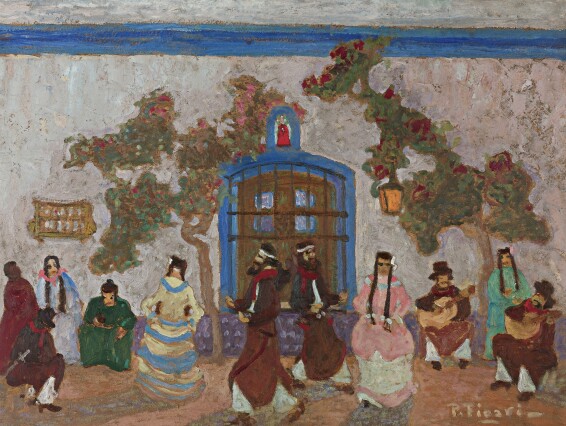- 14
Pedro Figari (1861-1938)
Description
- Pedro Figari
- Baile Criollo
- signed lower right; titled on the reverse
- oil on board
- 24 1/2 by 32 1/4 in.
- 62.2 by 81.9 cm
- Painted circa 1925.
Provenance
Private collection, Paris
Sale: Christie's, New York, Latin American Paintings, Drawings and Sculpture, November 21-22, 1989, lot 172, illustrated in color
Sale: Sotheby's, New York, Latin American Art, Part I, November 25, 1997, lot 77, illustrated in color
Condition
In response to your inquiry, we are pleased to provide you with a general report of the condition of the property described above. Since we are not professional conservators or restorers, we urge you to consult with a restorer or conservator of your choice who will be better able to provide a detailed, professional report. Prospective buyers should inspect each lot to satisfy themselves as to condition and must understand that any statement made by Sotheby's is merely a subjective qualified opinion.
NOTWITHSTANDING THIS REPORT OR ANY DISCUSSIONS CONCERNING CONDITION OF A LOT, ALL LOTS ARE OFFERED AND SOLD "AS IS" IN ACCORDANCE WITH THE CONDITIONS OF SALE PRINTED IN THE CATALOGUE.
Catalogue Note
It was not until the age of 60 after a successful career as a lawyer, journalist, and politician that Pedro Figari turned to painting full time. His paintings portray what is uniquely beautiful and intrinsic to the everyday life of the Rio de la Plata. There is a lyrical serenity and familiarity that Figari captures that is unlike any of his contemporaries.
In his work we are privy to intimate moments of solitary reflection and joyous celebrations of dance and music. Jorge Luis Borges refers to Figari's subject as "creole immemorialities" referring to those elements that are native to the region – a shared "mate" tea of friendship, a mahogany bonfire, the "ombù" tree that welcomes from afar to provide shade and shelter for both birds and humans, all these represented and left as testimony in Figari's work.
"Baile Criollo" offers a direct and personal view of a courtyard celebration held in a country home. The rhythm of the dancing figures is echoed in the trees that frame the central window and the viewer almost hears the music played by the figures on the right. Even the ribbons in the ladies' hair, along with the swaying hips and patting feet seem to repeat this chromatic rhythm that invites the viewer to step right in and dance.

